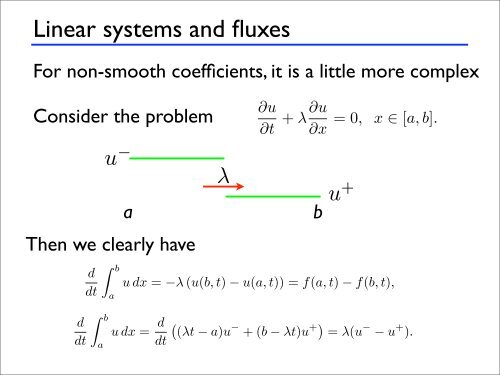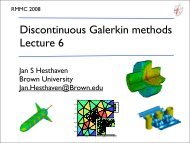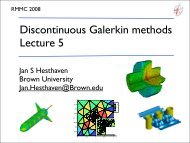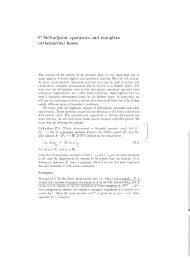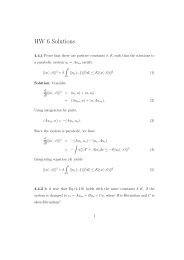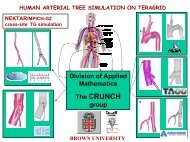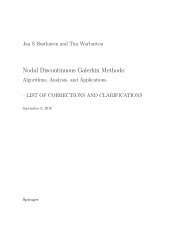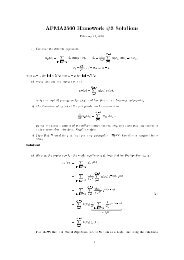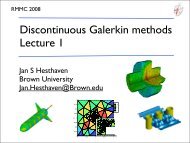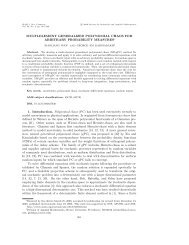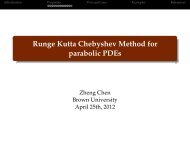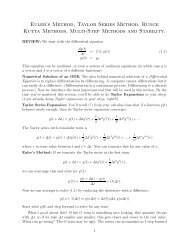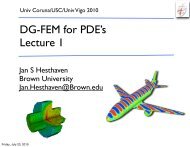Discontinuous Galerkin methods Lecture 3 - Brown University
Discontinuous Galerkin methods Lecture 3 - Brown University
Discontinuous Galerkin methods Lecture 3 - Brown University
You also want an ePaper? Increase the reach of your titles
YUMPU automatically turns print PDFs into web optimized ePapers that Google loves.
know that<br />
with λ > 0; that is, the wave corresponding to λ1 is entering the domain, the<br />
λ1 = −λ, λ2 =0, λ3 = λ,<br />
Linear systems and fluxes<br />
∀i : −λiQ[u − − u + ] + [(Πu) − − (Πu) + ]=0<br />
wave corresponding to λ3 is leaving, and λ2 corresponds to a stationary wave<br />
must hold across each wave. This is also known as the Ra<br />
condition and is a simple consequence of conservation of u ac<br />
discontinuity. To appreciate this, consider the scalar wave eq<br />
∂u<br />
Consider the problem + λ∂u =0, x ∈ [a, b].<br />
∂t ∂x<br />
Integrating u over the interval, we have<br />
−<br />
with λ > 0; that is, the wave corresponding to λ1 is entering the domain, the<br />
wave corresponding to λ3 is leaving, and λ2 corresponds to a stationary wave<br />
as illustrated in Fig. 2.3.<br />
Following the well-developed theory or Riemann solvers [218, 303], we<br />
know that<br />
∀i : −λiQ[u<br />
λ<br />
− − u + ] + [(Πu) − − (Πu) + as illustrated in Fig. 2.3.<br />
Following the well-developed theory or Riemann solvers [218, 303], we<br />
know that<br />
∀i : −λiQ[u<br />
]=0, (2.20)<br />
must hold across each wave. This is also known as the Rankine-Hugoniot<br />
condition and is a simple consequence of conservation of u across the point of<br />
discontinuity. To appreciate this, consider the scalar wave equation<br />
− − u + ] + [(Πu) − − (Πu) + ]=0, (2.20)<br />
must hold across each wave. This is also known as the Rankine-Hugoniot<br />
condition and is a simple consequence of conservation of u across the point of<br />
discontinuity. To appreciate this, consider the scalar wave equation<br />
∂u<br />
+ λ∂u =0, x ∈ [a, b].<br />
∂t ∂x<br />
For non-smooth coefficients, it is a little more complex<br />
d<br />
dt<br />
Then we clearly have<br />
b<br />
Integrating over the interval, ∂u we have<br />
∂t a<br />
∂x<br />
b<br />
d<br />
Integrating over the interval, we have<br />
u dx = −λ (u(b, t) − u(a, t)) = f(a, t) − f(b<br />
a + λ∂u =0, x ∈ [a, b]. b<br />
since f u= dx λu. = −λ On(u(b, thet) other − u(a, hand, t)) = f(a, since t) −the f(b, wave t), is propagati<br />
dt a<br />
speed, λ, we also have<br />
b<br />
d<br />
dt<br />
u dx = d<br />
dt<br />
u +<br />
since f = λu. d On the u dx other = −λ hand,<br />
dt (u(b, t) since − u(a, thet)) wave = f(a, is propagating t) − f(b, t), at a constant<br />
speed, λ, we also b<br />
a have<br />
b<br />
(λt − a)u − +(b − λt)u + = λ(u −<br />
since f = λu. d On the other ahand,<br />
since the wave is propagating at a constant<br />
speed, λ, we alsou dt<br />
have dx = d − +<br />
(λt − a)u +(b− λt)u<br />
dt<br />
= λ(u − − u + ).<br />
Taking a → x− and b → x + a<br />
, we recover the jump conditions<br />
d b<br />
d − + Taking a → x − +<br />
− and b → x + , we recover the jump conditions


